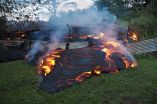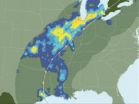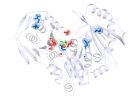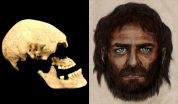Salivary mucins play active role to fight cavities
2014-11-11
(Press-News.org) Salivary mucins, key components of mucus, actively protect the teeth from the cariogenic bacterium, Streptococcus mutans, according to research published ahead of print in Applied and Environmental Microbiology. The research suggests that bolstering native defenses might be a better way to fight dental caries than relying on exogenous materials, such as sealants and fluoride treatment, says first author Erica Shapiro Frenkel, of Harvard University, Cambridge, MA.
S. mutans attaches to teeth using sticky polymers that it produces, eventually forming a biofilm, a protected surface-associated bacterial community that is encased in secreted materials, says Frenkel. As S. mutans grows in the biofilm, it produces organic acids as metabolic byproducts that dissolve tooth enamel, which is the direct cause of cavities. "We focused on the effect of the salivary mucin, MUC5B on S. mutans attachment and biofilm formation because these are two key steps necessary for cavities to form," says Frenkel.
"We found that salivary mucins don't alter S. mutans' growth or lead to bacterial killing over 24 hours," says Frenkel. "Instead, they limit biofilm formation by keeping S. mutans suspended in the liquid medium. This is particularly significant for S. mutans because it only causes cavities when it is attached, or in a biofilm on the tooth's surface." She adds that the oral microbiome is better preserved when naturally occurring species aren't killed. "The ideal situation is to simply attenuate bacterial virulence," she says.
The study grew out of previous work in the investigators' laboratory showing that other types of mucins, such as porcine gastric mucins, had protective effects against common lung pathogens, says Frenkel. With this in mind, they suspected that salivary mucins would play a protective role, but they were not sure what that would be.
"Defects in mucin production have been linked to common diseases such as asthma, cystic fibrosis, and ulcerative colitis," says Frenkel. "There is increasing evidence that mucins aren't just part of the mucus for structure or physical protection, but that they play an active role in protecting the host from pathogens and maintaining a healthy microbial environment. We wanted to apply these emerging ideas to a disease model that is a widespread, global public health problem--cavities. We chose to study the interaction of MUC5B with Streptococcus mutans because it is the primary cavity-causing bacteria in the oral cavity."
The research makes a fundamental contribution to scientific understanding of host-microbe interactions, says principal investigator Katharina Ribbeck, of the Massachusetts Institute of Technology, Cambridge MA. "It is generating a paradigm shift from the textbook view of mucus as a simple catchall filter for particles, towards the understanding that mucus is a sophisticated bioactive material with powerful abilities to manipulate microbial behavior."
INFORMATION:
Applied and Environmental Microbiology is a publication of the American Society for Microbiology (ASM). The ASM is the largest single life science society, composed of over 39,000 scientists and health professionals. Its mission is to advance the microbiological sciences as a vehicle for understanding life processes and to apply and communicate this knowledge for the improvement of health and environmental and economic well-being worldwide.
ELSE PRESS RELEASES FROM THIS DATE:
2014-11-11
From this week's Eos: Scientists Engage With the Public During Lava Flow Threat
On 27 June, lava from Kīlauea, an active volcano on the island of Hawai`i, began flowing to the northeast, threatening the residents in Pāhoa, a community in the District of Puna, as well as the only highway accessible to this area. Scientists from the U.S. Geological Survey's Hawaiian Volcano Observatory (HVO) and the Hawai`i County Civil Defense have been monitoring the volcano's lava flow and communicating with affected residents through public meetings since 24 August. Eos recently ...
2014-11-11
The majority of people - including healthcare professionals - are unable to visually identify whether a person is a healthy weight, overweight or obese according to research by psychologists at the University of Liverpool.
Researchers from the University's Institute of Psychology, Health and Society asked participants to look at photographs of male models and categorise whether they were a healthy weight, overweight or obese according to World Health Organisation (WHO) Body Mass Index (BMI) guidelines.
They found that the majority of participants were unable to correctly ...
2014-11-11
CHAMPAIGN, Ill. -- Tiny, thin microtubes could provide a scaffold for neuron cultures to grow so that researchers can study neural networks, their growth and repair, yielding insights into treatment for degenerative neurological conditions or restoring nerve connections after injury.
Researchers at the University of Illinois at Urbana-Champaign and the University of Wisconsin-Madison created the microtube platform to study neuron growth. They posit that the microtubes could one day be implanted like stents to promote neuron regrowth at injury sites or to treat disease.
"This ...
2014-11-11
WEST LAFAYETTE, Ind. - Crop producers and scientists hold deeply different views on climate change and its possible causes, a study by Purdue and Iowa State universities shows.
Associate professor of natural resource social science Linda Prokopy and fellow researchers surveyed 6,795 people in the agricultural sector in 2011-2012 to determine their beliefs about climate change and whether variation in the climate is triggered by human activities, natural causes or an equal combination of both.
More than 90 percent of the scientists and climatologists surveyed said they ...
2014-11-11
Located hundreds of miles inland from the nearest ocean, the Midwest is unaffected by North Atlantic hurricanes.
Or is it?
With the Nov. 30 end of the 2014 hurricane season just weeks away, a University of Iowa researcher and his colleagues have found that North Atlantic tropical cyclones in fact have a significant effect on the Midwest. Their research appears in the Bulletin of the American Meteorological Society.
Gabriele Villarini, UI assistant professor of civil and environmental engineering, studied the discharge records collected at 3,090 U.S. Geological Survey ...
2014-11-11
COLUMBIA, Mo. - Glycogen storage disorders, which affect the body's ability to process sugar and store energy, are rare metabolic conditions that frequently manifest in the first years of life. Often accompanied by liver and muscle disease, this inability to process and store glucose can have many different causes, and can be difficult to diagnose. Now, researchers at the University of Missouri who have studied enzymes involved in metabolism of bacteria and other organisms have catalogued the effects of abnormal enzymes responsible for one type of this disorder in humans. ...
2014-11-11
What if you researched your family's genealogy, and a mysterious stranger turned out to be an ancestor?
That's the surprising feeling had by a team of scientists who peered back into Europe's murky prehistoric past thousands of years ago. With sophisticated genetic tools, supercomputing simulations and modeling, they traced the origins of modern Europeans to three distinct populations.
The international research team published their September 2014 results in the journal Nature.
XSEDE, the Extreme Science and Engineering Discovery Environment, provided the computational ...
2014-11-11
Reston, Va. (November 11, 2014) - A novel study demonstrates the potential of a novel molecular imaging drug to detect and visualize early prostate cancer in soft tissue, lymph nodes and bone. The research, published in the November issue of the Journal of Nuclear Medicine, compares the biodistribution and tumor uptake kinetics of two Tc-99m labeled ligands, MIP-1404 and MIP-1405, used with SPECT and planar imaging.
Prostate cancer is the most commonly diagnosed non-skin cancer in the United States, and it is second only to lung cancer as the leading cause of cancer ...
2014-11-11
If you're a native of rural Mozambique who contracts HIV and becomes symptomatic, before seeking clinical testing and treatment, you'll likely consult a traditional healer.
Your healer may well conclude that your complaints are caused by a curse, perhaps placed upon you by a neighbor or by the spirit of an ancestor. To help you battle your predicament, the healer will likely cut your skin with a razor blade and rub medicinal herbs into the cut.
A recent survey of symptomatic HIV-positive people in rural Mozambique, led by Carolyn Audet, Ph.D., M.A., assistant professor ...
2014-11-11
New research from the Johns Hopkins Bloomberg School of Public Health suggests that HIV-infected adults are at a higher risk for developing heart attacks, kidney failure and cancer. But, contrary to what many had believed, the researchers say these illnesses are occurring at similar ages as adults who are not infected with HIV.
The findings appeared online last month in the journal Clinical Infectious Diseases.
Researchers say these findings can help reassure HIV-infected patients and their health care providers.
"We did not find conclusive evidence to suggest that ...
LAST 30 PRESS RELEASES:
[Press-News.org] Salivary mucins play active role to fight cavities







